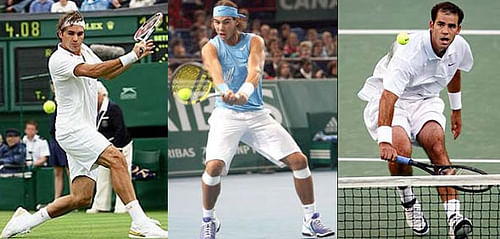
Hunting the "GOAT"

Tennis, as with any other sport, has had its share of greats over its more than 100 year old history. With progress being made in the game in virtually every decade, each decade has in turn produced its champions, its rivalries and carved its own place among tennis folklore. While a comparison of the greatest players over decades may be impossible, wrong and even unfair, tennis fans will never rest and the debate of who the ‘GOAT’ (Greatest of all time) is will continue now and in the future. Here’s my spin on things, including the various parameters that could be used to ‘identify’ the GOAT and how greats from each era fared in each parameter:
For the sake of this discussion and at the cost of possibly offending many, I have chosen the following players as worthy candidates for the GOAT:
1.) Bill Tilden
2.) Rod Laver
3.) Bjorn Borg
4.) Pete Sampras
5.) Roger Federer
6.) Rafael Nadal
Number of majors won: Many people claim that the number of Grand Slam titles won by a player determines their greatness in comparison to others. A lot of players win titles throughout the year, but winning a Grand Slam means winning seven best-of-five set matches within 2 weeks and involves a lot of physical and mental effort. Winning a Grand Slam is pretty much the pinnacle of every tennis player’s career and with all six players in that list having won 10 or more slams, they deserve to be counted among the greatest of all time.
Among the six though, Federer clearly heads that list having won his 17th major this July at Wimbledon. Sampras follows in second place with 14, Laver next with 12, Borg and Nadal tied at 11 and finally, Bill Tilden at 10. However, Sampras remains the only player in the list not to have won a ‘Career Slam’ i.e. won each slam at-least once, having fallen short at the French Open throughout his career. Tilden never entered the Australian Open, a commonplace occurrence given the lack of foreign players entering the tournament during the early part of the 20th century.
However, the actual meaning of the term ‘Grand Slam’ is often forgotten by many. The Grand Slam consists of four Grand Slam tournaments during the year and only one player, Rod Laver, has won the Grand Slam in the open era, in 1962 and 1969. This achievement is something even the great Roger Federer has not been able to accomplish and thus leads some tennis experts, especially those from a previous generation, to rate Laver higher than Federer.
Surfaces played on: While Laver did win the Grand Slam twice, something that must be noted is that 3 of the 4 slams were played on grass back in Laver’s era, making it easier for a serve-and-volley player like him to win. As the Australian Open and US Open moved to hard-courts during the 80’s, it became harder for players to adapt their game to different surfaces. Bjorn Borg managed the almost impossible task of winning the French Open and Wimbledon back-to-back in three different years, with only Nadal (twice) and Federer (once) having achieved a similar feat. Sampras, a natural serve and volley player was most at home at Wimbledon, and won a combined seven titles at the Australian and US Opens, but could never conquer the clay of Roland Garros. Federer has won the French Open only once, while Nadal has also had solitary wins at the Australian and US Opens, thus providing no real player who has mastered all surfaces. However, in this parameter, the winner for me would be Borg. During the late 70’s and 80’s, where there was a marked difference in clay and grass courts (the difference in speeds have been neutralized off-late), he won five straight Wimbledon titles and six French Open titles within a period of 8 years, establishing his supremacy as perhaps the most adaptable player of all time.
Quality of competition: While it is unfair to compare players from different eras, a good parameter to compare them is the quality of competition they faced. Sometimes, players may be so good that they dominate even the best players of their generation and sometimes the competition could genuinely be weak, allowing players to dominate. What is rare about the Federer-Nadal era is that it is perhaps the only generation which has seen two players dominate tennis, with Federer having an edge over Nadal, but still not being completely dominant as players of the past. A lot of Federer’s initial success came before the onset of Nadal, but people forget that he had to contend with promising players of his generation such as Hewitt, Roddick, Safin, Ferrero and Nalbandian before establishing complete supremacy over them. With the 80s considered a ‘golden age’ for tennis, it is validated by the fact that no player from that era completely dominated tennis. Sampras faced his main competition from Agassi, but also had his fellow Americans – Courier and Chang to deal with along with players like Ivanisevic, Rafter and Kafelnikov. Bill Tilden’s era was the weakest, with tennis not even a professional sport by then and with Rod Laver not playing the game for six years during the 60s, it is hard to pin-point any real rivals for the legend.
Conclusion: All said and done, this is a debate that should perhaps never have arisen but at the same time, is something that will never die down. It is unfair and not possible to compare players from different eras, and thus even though they could be compared using various parameters, time travel has not yet been invented and therefore we will never really get the answer to the question as to ‘Who is the GOAT?’.